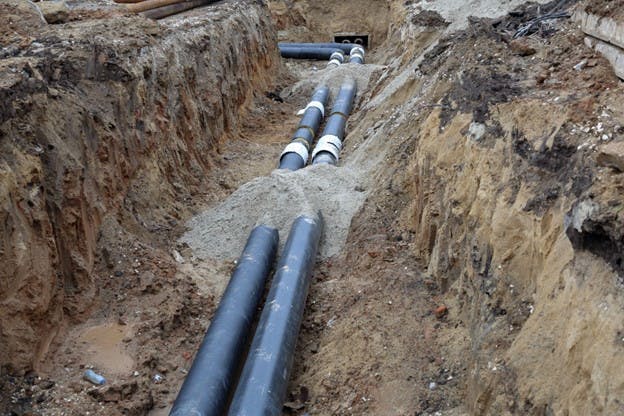September 2023
Your Pool Water Explained: Total vs. Free vs. Combined Chlorine
There is very little out there more important to human life than clean, sanitized water. Whether it’s your drinking water, bathwater, or you’re filling up a pool, you want your water quality to be as high as possible. That means it should be as free from contaminants and microorganisms as possible.
There are many ways to handle water disinfection, but the most reliable way to do it safely is to use chlorine. That is, as long as it's used and measured correctly. The concentration of chlorine in your pool water or glass can be the difference between sanitization and sickness.
When it comes to chlorine though, it's not just about the dose. Chlorine has a surprising amount of other factors that determines its safety and effectiveness. The biggest of those is understanding the difference between total vs. free vs. combined chlorine.
Let’s go over each type of chlorine, how to measure them, when you want them in your water and when you don’t, and how to manage your levels, including how to filter them out.
What Is Chlorine and How Does It Work?
Chlorine is a powerful water disinfectant used for drinking water, swimming pools, and hot tubs. It’s also the main active ingredient in bleach and bleach products. Since the late 19th century, chlorine has been used in municipal water supplies around the world and it has saved countless lives. It is responsible for combatting once-rampant waterborne diseases like cholera, dysentery, and typhoid fever.
Many people credit the addition of chlorine to public water supplies as one of the greatest public health initiatives ever.
Why Do We Need Chlorine?
Chlorine was first used in the U.K. after a typhoid breakout in 1897. Its use spread across the globe from there and many common waterborne diseases were wiped out or made to be very rare.
Disinfecting water with chlorine is about a lot more than typhoid though. Water is teeming with bacteria, algae, and other microorganisms that can make us sick. Water is also a universal solvent. That means it dissolves and absorbs some of just about everything it touches. Chlorine is able to combat a surprising number of these contaminants.
Before chlorine we did have many other methods of disinfecting water, like sand filters, using plant roots to soak up toxins, leaving it in the sun, or boiling it, but those all require more work and energy and they aren’t as effective. If you look at boiled water, for instance, as soon as it cools it can easily be contaminated again.
Chlorine, on the other hand, sticks around in water for a while, so your water is protected over time instead of being able to immediately start developing new pathogens. Modern water municipalities need to send water to homes and businesses through pipes which can sometimes run for hundreds of miles. Chlorine can protect your water the whole way there.
How Does Chlorine Work?
Chlorine is a powerful oxidizer that combines and interacts with a variety of water contaminants. When added to water, chlorine can break down into other chemicals like hypochlorous acid (HOCI) and hypochlorite ion (CIO). These are powerful biocides that can damage the cell walls of bacteria and viruses, ultimately killing or inactivating them so you don’t get sick. Chlorine can also interfere with DNA and RNA and stop bacteria and viruses from reproducing and spreading. If a virus can’t reproduce, it can’t hurt you.
What Is Total vs. Free vs. Combined Chlorine?
Do you know the difference between total chlorine, free chlorine, and combined chlorine? If you’re treating your own water from a private well or need to keep your pool chlorine balanced, it pays to know these different types of chlorine.
What Is Free Chlorine?
Free chlorine is the amount of chlorine in water that is available to sanitize or disinfect the water. It’s the chlorine that hasn't yet reacted with contaminants, which means it's “free” to kill harmful bacteria, viruses, and other microorganisms.
When measuring chlorinated water for free chlorine levels, you’re really looking for how much of the chlorine in your water is still able to do the job of disinfection. For pool maintenance, the amount of free chlorine you want is 1-3 parts per million (ppm).
What Is Combined Chlorine?
Combined chlorine, sometimes referred to as chloramines, is used-up chlorine. When chlorine comes in contact with organic matter, it will combine with nitrogen and ammonia, which makes it less active and effective for disinfecting more water. Your combined chlorine levels are a measure of how much of your total chlorine is no longer useful.
Chlorine can act in a variety of different ways and create different compounds depending on what it comes in contact with. In some cases, combined chlorine not only loses effectiveness but can become a nuisance.
In swimming pool water, the nitrogen in sweat, sunscreen, and urine mix with the chlorine to create combined chlorine. This chlorine can irritate a swimmer's skin, eyes, and nose.
The intense chlorine smell in some pools is actually from the amount of combined chlorine in the pool, not the free chlorine. Combined chlorine is less effective at sanitizing more contaminants but it is more stable than free chlorine, so it hangs around longer.
Water utilities have found a way to take advantage of this. Many water utilities now use specially formulated chloramines that combine ammonia with chlorine as a secondary disinfectant.
These chloramines are still less effective than free chlorine but potent enough to do the job if they have enough contact time with the water. This is perfect for cities that send their drinking water through hundreds of miles of pipes to get it to customers. The water has plenty of contact time and the utility doesn’t have to worry about the chlorine dissipating mid-trip and no longer protecting the water.
What Is Total Chlorine?
Total chlorine is the amount of free chlorine in water plus the combined chlorine. Finding the total chlorine level and subtracting the free chlorine is a simple formula to determine how much combined chlorine you have in your water. Too much combined chlorine in a pool or hot tub could be a problem you’ll need to deal with.
Which Is More Important: Total Chlorine or Free Chlorine?
Both total chlorine and free chlorine are important to understand. If you don’t have enough free chlorine, your water will not be disinfected no matter how high your total chlorine is. But knowing your total chlorine gives you the data needed to determine your combined chlorine levels, which can be a health hazard.
Should Free Chlorine and Total Chlorine Be the Same?
In a perfect world, these two numbers should be the same because it means all of your chlorine is actively working to disinfect your water and you have no harmful combined chlorine. In practice, you’re likely to have some combined chlorines in your water.
If your free chlorine is way lower than your total chlorine you may have to take some action to improve it. Slight differences are to be expected.
Can You Have Free Chlorine But No Combined Chlorine?
Yes, it’s possible to have free chlorine and no chloramines if no contaminants are present in the water. But this condition can change very easily, which makes regular water testing necessary. Contaminants in this case could be sweat, cosmetics, bacteria, and even sunscreen.
Is Combined Chlorine the Same as Total Chlorine?
No. Combined chlorine is chlorine that has been used up, or has combined with a water contaminant. Total chlorine is the sum of combined chlorine (used) and free chlorine (unused) that is present in the water.
What to Do if Free Chlorine Is Lower Than Total Chlorine
If you find your free chlorine in your swimming pool to be slightly below your total chlorine, you probably don’t need to do anything. However, if your combined chlorine gets up above 0.4 ppm, you’ll probably need to shock your pool. This usually means adding more chlorine to your pool.
Will Shocking a Pool Raise Free Chlorine?
Yes, shocking the pool will raise your free chlorine. When you add more chlorine it will break apart the combined chlorine, leaving you with more free chlorine to attack those contaminants. Depending on the condition of your pool, how much chlorine you already have in it, and what your goals are, you can also use non-chlorine shock. This is a gentler but far less powerful approach.
Can You Swim in a Pool With Combined Chlorine?
Yes, but only if the level of combined chlorine is low enough. If the level gets above 0.4 ppm, the combined chlorine can be an eye and skin irritant. It's best to shock the pool if the combined chlorine gets too high or the free chlorine drops below 1 ppm.
Is Chlorine Dangerous in Drinking Water?
Municipalities regularly use chlorine and chloramines when treating water. While these are not known to be dangerous in the amounts used, they can present some problems like a foul odor and taste.
Chlorine and chloramines can also create dangerous disinfection byproducts like trihalomethanes, which are known to increase the risk of certain cancers.
Because chlorine is very reactive, it can easily be filtered out with a standard activated charcoal filter. However, chloramines, which are made less reactive by combining them with ammonia, last longer and are more stable. They require a catalytic carbon filter or a reverse osmosis filter instead.
Keeping Your Water Clean Is Easy With the Right Tools
Understanding the difference between total chlorine, free chlorine, and combined chlorine is imperative if you want to keep your water quality levels high.
Free chlorine is the active chlorine that hasn’t been used up yet. Combined chlorine has already attached itself to other contaminants, so it’s no longer effective. If you add how much of each of those you have, that’s your total chlorine. Remember that the status of your water can change quickly, so testing often is key.
If you don’t want your drinking water to smell like your swimming pool, HomeWater can help. We have a variety of water filters and water softeners formulated to drastically reduce chlorine in all of its forms from your tap.
Our American-made UPSTREAM 4-Stage Whole Home Water Filter uses a unique blend of red flint, KDF55, and catalytic carbon to deliver superior filter performance to every faucet in your home. It easily filters particulates, heavy metals, chlorine, VOCs, PFOS/PFAS, and more.
If you’re not sure of your filter needs, take our fast Filter Quiz and get our best recommendation in minutes.
Related Articles
September 2023
What Are the Benefits of Catalytic Carbon Filters?
September 2023


